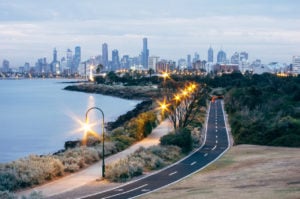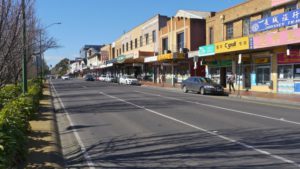[ad_1]
Please use the menu below to navigate to any article section:
Considering an investment into the Melbourne property market but don’t know where to start?
Then you’re probably wondering: “where are the best locations to invest in Melbourne property in 2022?”
Well…unlike some of Australia’s other major cities, Melbourne’s house values were severely impacted by the state’s extended Coronavirus lockdown in 2020 and 21, so they still have quite a fit of catching up to do.
But while the state’s property market suffered a dip, since late October, the Melbourne market has rebounded strongly.
Since the city emerged from its first round of lockdowns in late-2020, Melbourne house prices have risen rapidly and still have plenty of life left in them.
Median property prices for Melbourne
| Median/average value/price | MoM change | QoQ change | Annual change | |
| Capital city dwellings | $788,484 | 0.6% | 2.4% | 16.3% |
| Capital city houses | $986,992 | 0.6% | 2.8% | 19.5% |
| Capital city units | $626,449 | 1.0% | 1.7% | 9.0% |
| Regional dwellings | $533,279 | 0.5% | 5.0% | 24.0% |
Source: Corelogic, 1 December 2021
What is a property hotspot?
But first things first…
There might be a lot of talk around about certain property ‘hotspots’ which are said to guarantee investment return.
But I don’t believe in hotspots or investing in an area just because it is expected to be the “Next Best Thing”.
As far as I’m concerned, this year’s “hot-spots” tend to be next year’s “not-spots” and I’m a long-term investor, and base my decisions on fundamentals. I do not gamble.
So my approach to this list of top Melbourne suburbs for 2022 is seeing it as the opportunity to highlight those strong and stable suburbs that have both shown consistent historical growth and also have the right demographics to suggest future long-term growth.
And let’s not forget one of the most vital things to remember…
Neighbourhood is now more important than ever
In the new post-Covid world, the ability to work, live and play all within 20 minutes’ reach of home is the new gold standard desirable lifestyle.
If social distancing and the Coronavirus have taught us anything, it has taught us the importance of the neighbourhood we live in.
If you can leave your home and be within walking distance of, or a short trip to, a great shopping strip, your favourite coffee shop, amenities, the beach, a great park, the recently implemented coronavirus restrictions might seem a little more palatable than if you had none of that on your doorstep.
But the reality is, this concept is nothing new.
In fact, the rise of the 20-minute neighbourhood started long before Covid19.
You will find these are often in the gentrifying aspirational lifestyle suburbs of our capital cities and people will pay a premium to either own a property in these locations or rental property in these locations.
Many of Melbourne’s inner suburbs and middle ring suburbs already meet the 20-minute neighbourhood test.
However very few of the outer suburbs would do so.
Follow the demographics
According to leading demographer Bernard Salt, the coming of the coronavirus has changed the Australian workforce and not just by prompting adaptation to new technology like Zoom calls and triggering a work-from-home movement, but also by rigidly dividing the nation according to skill sets.
The Australian Bureau of Statistics classifies every job according to one of five skill levels with Skill Level 1 being the most skilled.
It is well recognised that the rich – such as people with a Skill Level I job – are getting richer, and at the other end of the spectrum, Skill Level 5 jobs requiring little or no previous work experience (like general sales assistant, kitchen hand) are experiencing no wages growth.
A Skill Level 1 job requires a bachelor’s degree or higher, or the equivalent of at least five years’ training.
People with these types of jobs will earn more income and be able to afford to pay more for their properties.
The pandemic cricket demand for skills in finance (accounting), risk management (solicitors), computer programming and many other skill levels one jobs.
However, the story for the balance of the workforce has been quite different.
So understanding where the skill level one worker lives in Melbourne is critical and be seen in the following graphic provided by Bernard Salt in The Australian.
Top Melbourne suburbs for 2022
Whether you are looking for a higher-end purchase or a beginning investor, I think these are the Melbourne suburbs that are set to take advantage of the changing face of the city.
Moving forward, it’s clear to me that for Melbourne, the higher and more affluent suburbs of Melbourne will be where property prices will outperform.
Meanwhile, cheaper suburbs on the outskirts of the city will enjoy a brief uptick thanks to significant population growth but I don’t recommend investing in these areas because I believe that moving forward, the properties in those suburbs will have lower capital growth.
So what are the best suburbs for investment?
Here I’ve broken down what I see are 16 suburbs to watch in Melbourne, listed by the area they are located, with help from data from Domain Group and Real Estate.com.au.
The municipality of Glen Eira
1. Caulfield

Average age: 60+
Caulfield is a well-regarded suburb that sits roughly 10km south-east of Melbourne’s CBD.
It is one of Melbourne’s best-serviced towns in terms of tram and train networks, which link Caulfield with the CBD as well as neighbouring suburbs such as Elsternwick and Glen Huntly.
Villa units and homes in the neighbouring gentrifying suburbs of Carnegie and GlenHuntly make great investments – they are highly sought after by home buyers and investors
2. Elsternwick
Total population: 10,353
Average age: 20-39
Just 9km from the Melbourne CBD, Elsternwick is a sought-after suburb. Surrounded by lots of good quality schools, the beach, and great amenities, the suburb is highly desirable for families in particular.
3. Ormond

Average age: 20-39
Median house price: $1,452,500
Ormond has a high density of owner-occupier properties at around 59% and the suburb’s demographic is split equally between families and single people.
It is gentrifying, has many cafes, shops, supermarkets in close proximity, great schools for both primary and secondary along with superb public transport.
4. Bentleigh and East Bentleigh
Total population: 27,635
Average age: 29-40
Bentleigh East is a high-demand market with good transport links, local schools, and plenty of amenities on the doorstep.
While the suburb mainly consists of established couples and families, it is a gentrifying suburb with many young families moving into the older houses or into the many new townhouses being built in Bentleigh.
It is serviced by good schools, great local shopping, and proximity to both Southland and Chadstone shopping centers.
5. McKinnon

Average age: 40-59
McKinnon has easy access to public transport and is within a short distance to the city.
It has several parks and schools, cafes and shops, and many other facilities within arm’s reach.
Like the surrounding suburbs of Bentleigh and Ormond, McKinnon is gentrifying with many new homes and townhouses being built.
The McKinnon High School catchment zone, which has recently been extended, is a great drawcard for both home buyers and tenants.
Bayside suburbs
6. Brighton
Total population: 23,354
Average age: 40-59
The bayside suburb of Brighton, just 11km from the CBD, is home to some of Melbourne’s wealthiest residents.
With a median house price at around $3 million, the suburb has some of the city’s grandest homes.
At the same time, a mini building boom of apartments provides a more affordable option for downsizers and investors.
The area has three railway stations, multiple shopping strips, cafes, restaurants, beaches, and some of the best schools available.
7. Hampton

Average age: 40-59
Adjoining prestigious Brighton, Hampton is a beachside suburb that hosted The Block this year.
Located just 14 kilometres from the CBD this gentrifying suburb has a lot going for it including a number of retail shopping precincts featuring restaurants, bistros, clothing stores, antique shops, and personal services.
8. Sandringham
Total population: 10,234
Average age: 40-59
Median house price: $1,844,000
Another high-demand market with bumper property prices to match.
This affluent family-focused beachside suburb is located 16 km southeast of CBD and has easy access to a variety of amenities.
 9. Beaumaris
9. Beaumaris
Total population: 13,330
Average age: 40-59
Median house price: $1,710,000
The small bayside suburb of Beaumaris is another high-demand market with an equally high median house price.
The area is dominated by families and is majority owner-occupied at 87% of current properties. Beaumaris has seen a compound growth rate of 5.0% for houses and 5.9% for units.
The municipality of Kingston
10. Cheltenham and Highett
Total population: 22,295
Average age: 40-59
Cheltenham is gentrifying, bridesmaid suburb that still represents good value relative to the neighbouring Highett suburb.
Both suburbs enjoy proximity to the large Southland shopping center and offer an affordable entry into a Bayside suburb and are close to the beach yet only 19 minutes from the CBD on the express train.
They offer a range of excellent schools and are tightly held suburbs with high owner-occupier appeal and have great parks, schools, shopping, and some of the best golf courses in Melbourne.
The adjoining suburbs of Parkdale and Mentone are also great investment locations
11. Parkdale
Total population: 11,744
Average age: 40-59
Further south, the suburb of Parkdale is another highly regarded beachside area with excellent schools, great sports facilities, shopping, cafes, restaurants, and excellent access to public transport.
12. Mordialloc
Total population: 8,166
Average age: 35-45
Mordialloc is considered to be a great lifestyle suburb with very limited shortcomings.
The beach is within close distance, as are cafes and restaurants. The suburb is 24km from the city and has easy access both by car and train.
The area also boasts great schools and childcare options.
Eastern suburbs
 13. Surrey Hills
13. Surrey Hills
Total population: 13,606
Average age: 40-59
Melbourne’s affluent eastern suburb of Surrey Hills has a high $1.75 million median house price.
The family-orientated area has a great focal point being Union Road shopping village which has great cafes, organic stores, and other shops.
Older villa units make great investments in Surrey Hills, especially when renovated.
14. Mount Waverley
Total population: 33,625
Average age: 40-59
Mount Waverley is another very family-friendly area where locals are mainly older couples and families with some younger single people.
The area has a relaxed lifestyle with lots of parks, schools, golf courses shopping, and access to public transport.
15. Box Hill

Average age: 25-35
Like much of Melbourne’s middle ring of eastern suburbs, Box Hill, 14 kilometers east of the city center, has become much sought-after by Asian and international buyers.
It’s a diverse suburb with good shopping and great schools.
16. Glen Waverley
Total population: 40,333
Average age: 40-59
Glen Waverley is orientated around young families and professionals.
The area enjoys a low crime rate and sits in the catchment for some of the best schools in the city.
The suburb sits just 19km south-east of the CBD, is residential in nature with substantial areas of commercial centered around the Glen Waverley Railway Station.
A little closer to the City and offering access to The Glen Shopping Centre, Glen Waverley Golf Course, and Central Reserve.
[ad_2]
Source link




 9. Beaumaris
9. Beaumaris 13. Surrey Hills
13. Surrey Hills